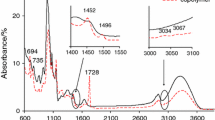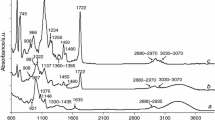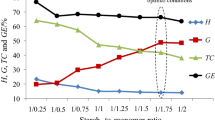Summary
Thermal degradation under N2atmosphere and thermoxidative degradation under air atmosphere of increasingly grafting efficiency values (i.e. GE%=0.0 to 35.5) for starch and starch grafted with N-tert-butylacrylamide thermosensitive copolymers (starch-g-BAM) by Ozawa and Kissinger methods using thermogravimetric analysis (TG) and differential scanning calorimetry techniques (DSC) at 10, 30 and 50% mass losses respectively have been studied. Influence of physical inter and intra molecular interactions on grafting and consequently on activation energy of degradation (E a,d) was investigated using Ozawa's method, whereas linear dependence of E a,don GE% by scaling relations using Kissinger's method was determined. Furthermore, the thermoxidative degradation induces the possibility of molecular rearrangement, cyclization and partial crosslinking that is deduced from the activation energy of degradation (E a,d) and residual mass of TG profile. Thermal stability of starch does not alter as a result of different grafting efficiency percentages.
Similar content being viewed by others
Author information
Authors and Affiliations
Rights and permissions
About this article
Cite this article
Fares, M., El-Faqeeh, A. Thermal and thermoxidative degradations of starch and thermosensitive starch-g-BAM copolymers. J Therm Anal Calorim 82, 161–166 (2005). https://doi.org/10.1007/s10973-005-0858-4
Issue Date:
DOI: https://doi.org/10.1007/s10973-005-0858-4




